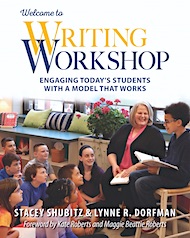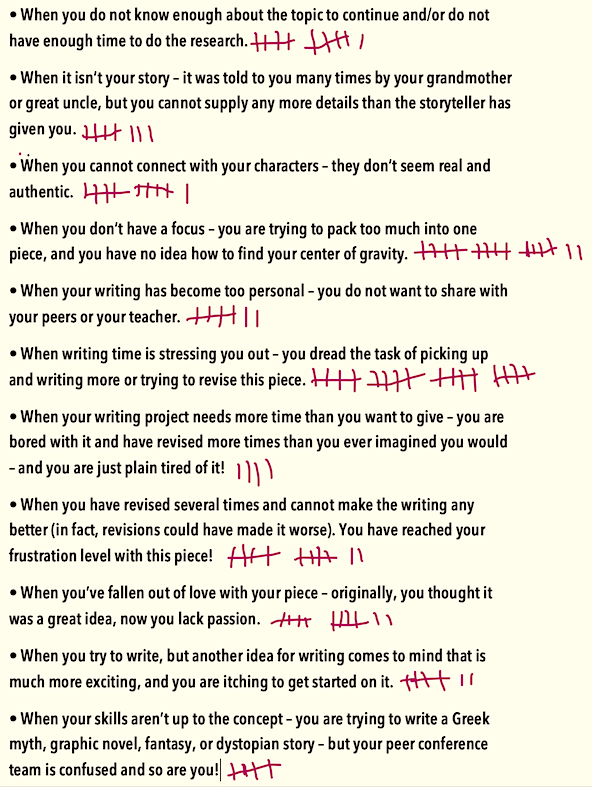Teaching Kids When to Let Go of a Writing Idea
Abandon (verb): to put an end to something planned or previously agreed to. Synonyms: call off, cancel, drop, recall, repeal, rescind, revoke, scrap. (Merriam-Webster)
How do we know when it is better to abandon a writing project, move on, and begin something new?
Yes – sometimes it’s a good idea to set it aside for a day or two, or even several weeks or months, returning to the writing with fresh eyes and renewed energy.
Often, however, our students do not have this luxury of time. They need to take a piece through the complete writing process and publish it for a grade. Knowing when to let go of a writing idea becomes a valuable skill.
Middle grades teachers should probably hold a discussion around the idea of abandoning a piece of writing as early as possible in the school year. From a big-picture perspective, teaching this concept might be included in ELA classrooms as soon as third or fourth grade – or sixth grade if you’re in a grades 6-8 school.
How to begin
Teaching student writers to reflect on their topics, themes, and drafts early on will save time and possibly eliminate lots of frustration.

An oral rehearsal with a partner – or even facing a wall or mirror or standing in a corner of the room to tell yourself the story out loud is helpful. Teachers can demonstrate with your own writing to show how you get started – what your process is – and how you move from one attempt to the next.
All writers have false starts and then find their momentum. But sometimes we decide not to finish a piece of writing. What are some signposts that guide our decision?
During a writerly discussion, ask students to turn and talk with their writing partners about when they should give up on a piece of writing to start something new. Ask them to jot down their thinking in their writer’s notebook and then share in whole group.
Place their thinking on an anchor chart and place each student’s initials next to the idea he/she contributed. Here are some ideas from sixth graders. I’ve removed their initials, but you can see tally marks to show how many times other students also had a similar item on their writer’s notebook list (click to enlarge):
It is hard to admit that something is broken and cannot be fixed, but not everything we start drafting will be brought to fruition as a published piece of writing. Abandoning a draft that isn’t working means you have acknowledged why it didn’t work. That is an accomplishment for a writer. It is part of the learning process.
Knowing when to abandon a draft is also a huge time saver. It means you won’t continue to work hard without reaping the rewards of finishing a satisfying piece. Sometimes, we just have to be content in knowing that some drafts aren’t meant to reach the finish line.
But maybe you developed an interesting character, or a great scene, or built your skills in writing conversations or developing a plot. This is no small feat. At a later date, perhaps you will return to a character, setting, or even a powerful line from the piece you left behind and be inspired to write something new.
Letting go is part of the writing process
Writers must be able to give themselves permission to throw away drafts with intent. We should not be afraid to empty our thoughts on paper and fill the trash can with writing that does not meet our standards or expectations. We need to know that some pieces are like stepping stones to get us to the piece of writing that will engage us and satisfy our readers.

Of course, we should tell our students that we don’t want to get into the habit of abandoning story after story. It is important to develop writing stamina and persevere when the going gets tough. Just let them know it’s okay to abandon a piece of writing every once in a while, in an effort to write a better piece that they will finish and enjoy.
Abandoning a writing piece doesn’t mean you’ve failed as a writer. It does not mean that the story or poem or memoir will never be shared. You can always come back to abandoned writing (I save mine in a brightly colored folder) to revise and publish. If you save them, sometimes years later you will have the wisdom and insight to use them to create something new and unique!

Lynne is the author of many literacy titles. She and co-author Brenda Krupp are putting the finishing touches on Welcome to Reading Workshop, to be published in late fall with Stenhouse Publishers and paired with Welcome to Writing Workshop: Engaging Today’s Students With a Model That Works, Lynne’s recent book written with Stacey Shubitz (Stenhouse, 2019).



































